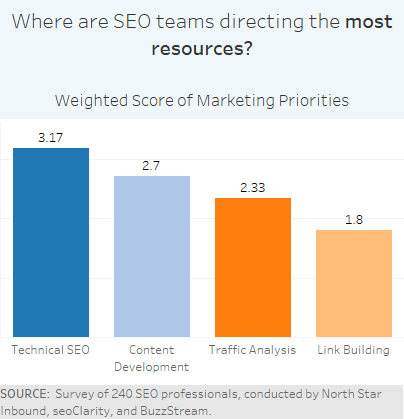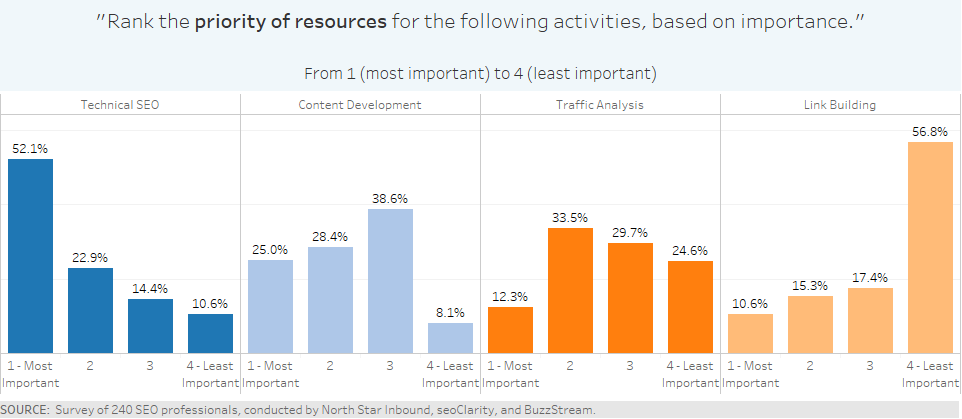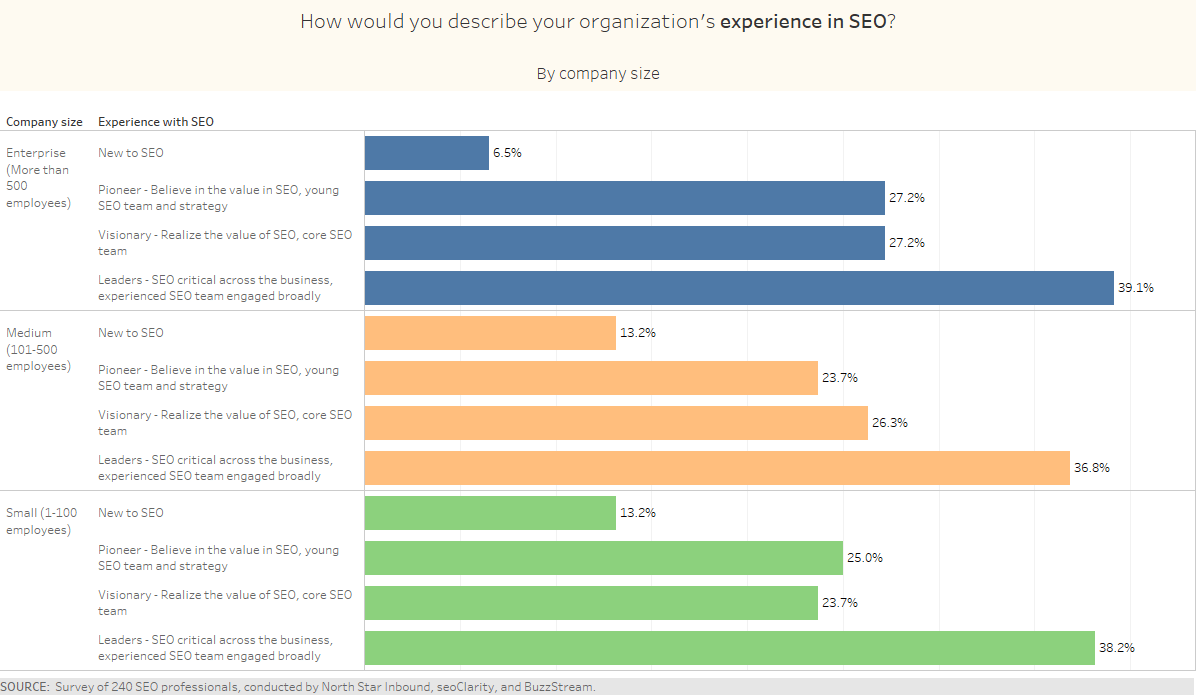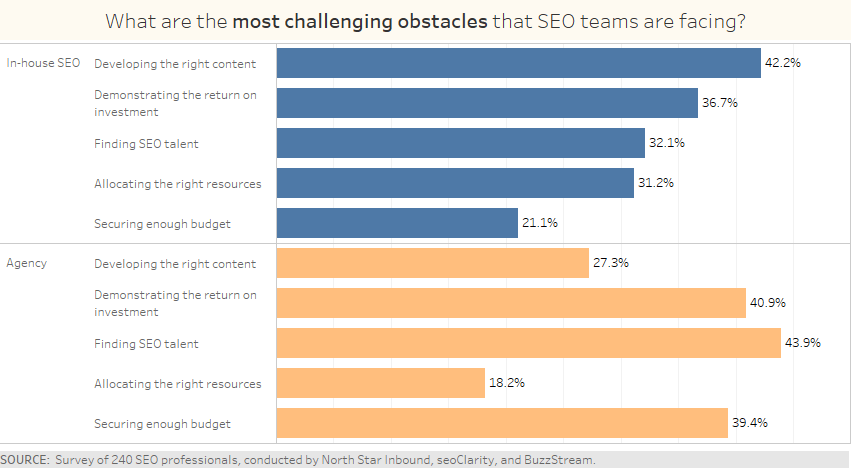Table of Contents
The field of SEO is evolving at a mind-boggling pace and getting more competitive every day. At North Star Inbound, we wanted to take the temperature of the industry, compare notes with our peers, and source the wisdom of the crowd. Which strategies are working well for enterprise-level SEO teams? Which ones are failing? How are companies preparing for mobile-first search?
To answer these questions – and more – we partnered with seoClarity and BuzzStream to develop the widest enterprise SEO survey to date. We picked the brains of 240 SEO specialists across the country. Keep reading to learn what we discovered.
11 Key Enterprise SEO Statistics
- Although enterprise level businesses generally outspend smaller firms when it comes to SEO, there is a broad range of budgets. While 45% of enterprise-level companies invest more than $20,000 a month to optimize search, a surprising 11% allocate less than $1,000 a month. 45% of companies invest more than $20k / month on SEO; 11% less than $1,000 / month Share on X
- The value of link-building is undisputed, but survey respondents overwhelmingly described it as the most difficult strategy to execute. They generally ranked it fourth – behind technical optimization, content development, and traffic analysis – in terms of priority. Link building is effective but the most difficult SEO strategy to execute. #StateofEnt SEO2017 Share on X
- Despite the difficulty of earning links from high-authority sources, 85% of survey respondents said they are maintaining or increasing their link-building budgets this year. 85% of survey respondents said they are maintaining or increasing their link-building budgets this year. #StateofEntSEO2017 @seoclarity @buzzstream Share on X
- The typical in-house SEO team has 2-5 members, regardless of whether the business has fewer than 100 employees or more than 1,000.
- Bigger teams and bigger budgets are positively correlated with SEO success. But in some cases, larger teams might be the result of businesses making SEO an all-hands-on-deck, company-wide priority, rather than hiring more dedicated specialists.
- Demonstrating ROI and securing SEO talent are both an obstacle for in-house and agency SEO specialists.Demonstrating ROI and securing SEO talent are both an obstacle for in-house and agency SEO specialists. Share on X
- Page speed and indexation are the top technical concerns for SEO teams, and 85.7% of our respondents said they’re hustling to be fully mobile-responsive before the rollout of Google’s mobile-first search index.Page speed and indexation are the top technical concerns for SEO teams, Share on X
- 59% of all respondents reported that the most effective SEO strategy used was technical onsite optimization.
- Keywords are king when it comes to content planning. In fact, 96% use Keyword Research and Topic Importance as the two deciding factors, but agencies and in-house SEOs differ over whether to put more emphasis on national or local keywords.
- Nearly 40% of responses answer Content Development as the most pressing SEO issues in 2017.Nearly 40% of responses answer Content Development as the most pressing SEO issues in 2017 Share on X
- When it comes to link-building, most teams are relying on public relations – reaching out to journalists and influencers directly to promote content – and guest posts.Most teams are relying on public relations for link building. Share on X
Enterprise SEO statistics for spending & priorities
If there is a magic number for how much to spend on SEO, our respondents couldn’t agree on what it might be. More than half of our survey-takers said their companies spend more than $5,000 a month on SEO, but there was a big spread of budget levels for companies of all sizes.
How much are companies spending on SEO?
Fig. 1.1

Although larger companies tend to outspend smaller businesses when it comes to SEO, we were surprised that even among enterprise level businesses (which we defined as having 500+ employees), there was significant representation across the spectrum:
- 11% of enterprise SEOs had a monthly SEO budget of less than $1,000
- 20% of enterprise SEOs had a budget of $5,000 to $10,000 per month
- 45% of enterprise SEOs had a budget of $20K+
This was valuable for our data, because it means all levels of “privilege” and development were represented in our study.
Fig. 1.2

Which activities are enterprise SEOs giving highest priority?
SEO covers a lot of ground. For our study, we broke it down into four main categories to get a sense of what companies are focusing on:
- Technical SEO – Back-end optimization, including DNS settings, structure, indexability, processing speed, caching, site security, and mobile functionality.
- Content Development – Ensuring that the site has an abundance of unique, easy-to-navigate information that is rich in keywords and is refreshed on a regular basis.
- Traffic Analysis – Examining search traffic, site performance relative to competitors, search intent, visitors per keyword, time on site, bounce rate, and other usage patterns.
- Link-building – Earning off-page backlinks, social media traction, and brand mentions from influencers and authoritative sites.
We asked our respondents where they are directing the most resources and found that, while SEO teams value all of the categories, they tend to prioritize technical optimization.
Fig. 1.3

When we broke our results down by company size, we discovered an astonishing level of consensus among small, medium, and enterprise level businesses.
Fig. 1.4

The survey question asked respondents to rank the four categories in order of priority, from 1 (most important) to 4 (least important). Although the weighted responses were consistent across all business sizes, looking at the actual answers reveals that there is still some disagreement among our SEO specialists. For instance, although they were a minority, 10.6% of our respondents ranked link-building highest.
Fig. 1.5

Enterprise SEO strategies & challenges
What are the most pressing issues facing enterprise SEOs in 2017?
When we asked about their most “pressing issues” SEOs are facing in 2017, we found that developing content was tops across the board with nearly 40% of all responses. However, enterprise-level companies are less concerned with outreach and link-building than small and medium-sized businesses. For enterprise-level SEOs, mobile responsiveness and user experience are more urgent.
Fig. 2.1

What’s working? Enterprise SEOs reveal their most successful strategies.
All of our respondents agreed that technical onsite optimization was their most successful SEO strategy over the past 12 months. But after that, small and large businesses had very different experiences. Enterprise SEOs found focusing on user experience and evergreen content to be most effective. Small businesses got bigger boosts from blogging and link-building.
Fig. 2.2

What are enterprise SEOs finding most difficult?
All of our SEOs are feeling the same pain when it comes to link-building. When we asked which strategy is most difficult to execute, each group chose getting high-quality links by a substantial margin. But after that, experiences differ based on company size. Enterprise-level businesses, which often have tens of thousands of website pages to monitor, ranked technical onsite optimization as their second-most-challenging strategy. It was less of a struggle for medium and small businesses, which ranked technical optimization fourth and sixth respectively.
Fig. 2.3

Enterprise SEO team statistics
How big is a typical SEO team?
One of the biggest surprises of our study was that the most common SEO team has 2 to 5 members, regardless of whether the company has fewer than 100 employees or more than 1,000. That was the size of 42.3% of our respondents’ teams overall. Another 32.2% had 6 or more people working on SEO, but 23% of our respondents said all responsibility falls on a single person at their company.
Fig. 3.1

Which teams are having the most SEO success?
We can’t say for certain whether our SEOs who feel frustrated are actually doing worse than those who feel successful. Perceptions of success are often influenced heavily how reality compares with expectations. But it was interesting to see that those spending more than $20,000 a month were most likely to be very satisfied or very frustrated.
Fig. 3.2

Companies that have larger teams or outsource to an agency were somewhat more likely to feel successful than those who put all of the burden on a single person.
Fig. 3.3

There was also an interesting disparity between agencies and in-house SEO teams when it comes to perception of success. While a whopping 42% of agencies called themselves successful – crushing it, while being scalable and repeatable – only 13% of in-house SEO teams shared this view of themselves. Only 17% of agencies had a negative take on the relative success of their current SEO strategy. In contrast, 38% of in-house SEOs felt poorly about their strategy’s success.
Fig. 3.4

How experienced are typical SEO teams?
The field of SEO is maturing. Among our 240 respondents, only 22 described their organization as “new to SEO.” More than a third said their companies are leaders that view SEO as critical across the business and have an experienced team that is engaged broadly. This was consistent across companies of all sizes.
Fig. 3.5

There was a clear correlation between organizations with more experience having bigger monthly budgets for SEO. It was less clear which came first – the spending or the experience. However, the results suggest that companies are seeing a return from the money they’ve invested in SEO and are continuing to prioritize it in their budgets.
Fig. 3.6

What organizational challenges do SEO teams face?
SEO is challenging, but the obstacles are slightly different depending on whether you’re on an agency or in-house team. In-house SEOs said their biggest hurdle is developing the right content, while agencies are struggling with finding SEO talent. In-house SEOs listed “securing enough budget” as the least of their worries, but it was a much bigger obstacle for agencies.
Both groups identified “demonstrating return on investment” as their second-most-challenging obstacle. While some SEO strategies are easy to measure, others take a long time to show results and are hard to prove in terms of cause-and-effect.
Fig. 3.7

Enterprise SEO technical priorities
What are the top technical issues that enterprise SEOs monitor?
Our survey respondents identified technical optimization as their highest priority and most effective strategy, which begs the question – what technical issues are they monitoring most closely? The answer for small, medium, and enterprise-level businesses was the same: page speed, indexation, and duplicate content. Small and medium-sized companies also wrestle with broken links, but that was less of an issue for enterprise-level firms.
Fig. 4.1

We included a free response option in this question, which led to some interesting fill-ins. We received a few “mobile friendliness” responses – from both agencies and in-house SEOs – which is a concern spreading like wildfire through the industry. We had a few mention “all”, underscoring the importance of a well-designed, comprehensive SEO approach – and the difficulty in teasing out individual factors as being more important than the others. Perhaps the most poignant response came from an in-house SEO, who really delivered a slice of the enterprise life: “200,000+ pages; we look at them all, but can only immediately react on canaries.”
Enterprise SEO content priorities
Our respondents were in sync when it comes to content strategy. Big and small, in-house and agency – the results were similar. Keyword research was the most important factor in determining which content to create or optimize, and search intent/search volume were the most important factors when analyzing keywords.
What drives content decision-making?
Fig. 5.1

Fig. 5.2

Enterprise SEO traffic analysis
Google Analytics is still the most valuable tool for monitoring and dissecting traffic, but most of our respondents had a variety of other tools in their stacks as well. Moz, Screaming Frog, and SEMrush ranked high for the insights they add. We asked our respondents to “check all that apply,” and 14 tools were used by more than 10% of the survey takers including BuzzStream and seoClarity.
Which tools are most valuable for SEO analysis?
Fig. 6.1

Which ranking factors do SEO teams monitor most closely?
How is SEO success being measured? We asked our respondents to tell us the two most important ranking factors they monitor. Keywords were far and away the most significant..
Fig. 6.2

Although keywords were tops for both in-house SEOs and agencies, they disagreed on which were most critical – national and local/regional keywords. National level keywords were the most important factor for 73% of in-house SEOs, but only 54% of agencies felt the same. Local/regional keywords were a distant ‘second’ top factor for in-house SEOs – with 36% of those polled noting it in their top two. For agencies, local/regional keywords actually won out over national level keywords.
Agencies and in-house teams differ on the value of some key ranking factors
Fig. 6.3

We have some theories for why this might be happening – though further research is warranted. With the exception of Internet-first companies, in-house SEO teams are often implemented to get their companies ‘up to speed’ with their marketing strategy. They tend to focus on well-established, traditional strategies as they work to build a solid foundation. Agencies are often engaged to push the envelope forward after clients have maxed out the standard techniques. As such, agencies tend to focus on newer and more innovative strategies.
Enterprise SEO link building priorities
What are SEO teams doing to earn links this year?
Survey respondents overwhelmingly described link-building as the most difficult SEO strategy to execute and they generally ranked it fourth – behind technical optimization, content development, and traffic analysis – in terms of priority. But despite the difficulty of earning links from high-authority sources, 85% of survey respondents said they are maintaining or increasing their link-building budgets this year. That was true for small, medium, and enterprise-level businesses.
Fig. 7.1

Which link-building tactics work best?
Of the link-building tactics they’ve used, enterprise SEOs resoundingly described PR as the most effective. Guest posts were a distant second for enterprise SEOs. The gap was narrower for smaller companies, but they still listed PR and guest posts as their top two tactics. Paid links and comments were the least effective methods for most survey takers.
Fig. 7.2

Which key performance indicators are most useful for tracking link-building campaigns?
When tracking link-building campaigns, most SEOs focus on Moz “domain authority” and “page authority” scores, and the number of linking root domains. Majestic’s “trust flow” metric was less popular.
FIg. 7.3

Adapting to change in the world of Enterprise SEO
Change is the rule in the world of SEO, and big innovations like the release of Penguin 4.0 often force teams to adapt their strategies. We wondered if SEO teams were using the “disavow” tool less since the Penguin rollout. We discovered that most (57%) are staying the course and continuing to manually suppress low-quality links that they believe are hurting their rankings.
Fig. 8.1

The next big shift will come later this year, when Google launches a mobile-first search index that could turn rankings upside down. We discovered that rather than truncating content or maintaining separate mobile sites, 85.7% of our survey respondents are making sure their web content is responsive across all platforms – desktop and mobile. That was consistent for all companies, big and small, and all SEO teams, regardless of whether they are part of an agency or in-house organization.
Conclusion
Few fields reinvent themselves as often as digital marketing, and the pace isn’t likely to slow any time soon. Advancements in messaging apps, artificial intelligence, augmented reality, and voice recognition are just some of the innovations that will keep SEO teams on their toes in the coming years. But the ever-shifting landscape bodes well for the industry as a whole. As teams get more experienced, they tend to budget more for SEO. For our part, at North Star Inbound we plan to keep growing and evolving, gleaning and sharing insights with our peers, and supporting our clients with the most effective strategies.
Methodology
We knew that ultimately we wanted this survey to take less than five minutes. We also knew we wanted to squeeze the most data out of this survey as possible. We brainstormed over 72 data points – and the associated questions we’d need to obtain them – and created a massive “master” survey from which to start editing. Senior members from each partner took the survey and made recommendations regarding what needed to be cut and refined.
Over the course of two weeks, the survey went through many revisions in terms of questions asked, question wording, answer choices, answer styles, and even formatting – all directed towards making it accurate yet taker-friendly. First we cut the survey down to fifteen minutes, then ten minutes, then five minutes, based on average survey length when administered to five people who had not seen the survey before. Those of us working on the survey took it many, many times.
Aside from our industry questions, the survey opened with some filtering questions to help ensure that it reached the intended crowd. These questions confirmed the taker’s involvement in SEO strategy, clarified whether they were in-house or agency, and gauged company size, SEO team size, and budget.
We opened the survey in the second week of April, and closed it in the second week of May. Each partner brought a list of enterprise SEO – both in-house and agency – contacts to reach out to via email. We sent an initial email inviting everyone to take the survey, and a follow-up two weeks later as a gentle reminder. We also promoted the survey via Twitter, Facebook, Inbound.org, Reddit, and LinkedIn Groups. We are grateful to Rand Fishkin, Marie Haynes, Jason Acidre, SEER, Distilled, WebCEO, and everyone else who helped us with this study.
There was no compensation or material incentive to participating in this survey, aside from receiving a copy of the report if the taker included their email address at the end. We wanted to make sure that anyone who participated was earnestly interested in contributing data in solidarity with our goals to clarify the state of the industry, and map out some next steps forward.
We were able to gather 240 responses from individuals involved in their company’s SEO strategy. Of our respondents, 88 work for small businesses (1-100 employees), 52 work for medium sized businesses (101-500 employees), and the largest group of 100 respondents work for enterprise level businesses (more than 500 employees). Two-thirds of the people who took the survey were in-house SEOs, which was very exciting for us: this was precisely the group of people whose brains we wanted to pick. 12% of those in-house SEOs work for small businesses, while a whopping 45% work for large enterprise SEO. In future iterations of this survey, we’d love to get even more enterprise SEOs to respond, but this was definitely a solid response for us.
Fair Use
If you’re a journalist or blogger interested in covering this project, feel free to use any of the insights or graphics found in this article. All we ask is that you kindly attribute the creators – North Star Inbound, seoClarity and BuzzStream – and link back to this page so your readers can learn more about our study.





